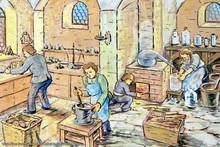Schindler’s Cobalt Blue Dye Works / Ultramarine factory
Schindler’s factory
The Schindler’s Cobalt Blue Dye Works was founded in 1649 by a trader from Schneeberg named Erasmus Schindler and is directly associated with the invention of the cobalt blue dye. In the following year, Erasmus Schindler built houses here, a mountain forge, operated a coal mine and was granted the right to slaughter and to bake. Subsequent owners of the factory built another “Herrenhaus” (baroque mansion), a commercial outpost, storehouses, and a grinding and cutting mill.
In the factory, the treasured cobalt blue dye was produced from cobalt ore. This cobalt blue dye is a neutral blue of high color saturation and was produced in powder form (pigment powder) and then put into barrels. This cobalt blue dye from Saxony was much sought-after throughout Europe, so that the number of workers in the cobalt blue factory of initially 14 increased up to 170.
The cobalt blue dye was especially in demand for textile manufacture, glass factories and porcelain factories. The still famous tile manufacturer from the Dutch Delft dyed their Delft tiles with this cobalt blue from Saxony and was a major customer of the Saxon “Blaufarbenwerke” (Blue Dye Works of Saxony).
After about 200 years, in 1855, the production of cobalt blue dye discontinued, and instead the factory was converted to produce the new ultramarine blue. This change in production was very costly and difficult, so regular production was not possible again until 1860. From 1878 on, the ultramarine blue dye made here was exported to Russia.
In later years the range of products expanded, and among other things, laundry blue in bags and cubes, pigment for artists and emulsion paints were made.
The terms “Schindlers Werk” (Schindler’s factory) or “Farbmühle” (dye mill) are used even today in the general public referring to the former blue dye-making company.
Photos and images on this page: www.photo-2u.de, Sammlung Beate Bauer, Sammlung Thomas Weigel
Europäischer Landwirtschaftsfonds für die Entwicklung des ländlichen Raums: Hier investiert Europa in die ländlichen Gebiete.














